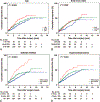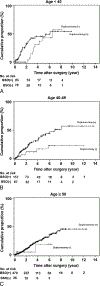Surgical menopause and increased risk of nonalcoholic fatty liver disease in endometrial cancer
- PMID: 26173075
- PMCID: PMC7526702
- DOI: 10.1097/GME.0000000000000500
Surgical menopause and increased risk of nonalcoholic fatty liver disease in endometrial cancer
Abstract
Objective: Our objective was to examine risk factors associated with development of nonalcoholic fatty liver disease (NAFLD) among women with endometrial cancer who underwent surgical staging with or without oophorectomy.
Methods: This is a retrospective study that evaluated endometrial cancer cases that underwent surgical staging (n = 666) and endometrial hyperplasia cases that underwent hysterectomy-based treatment (n = 209). This study included 712 oophorectomy cases and 163 nonoophorectomy cases. Archived records were reviewed for participant demographics, medical comorbidities, operative notes, histology results, and radiology reports for NAFLD. Cumulative risks of NAFLD after surgical operation were correlated to demographics and medical comorbidities.
Results: The cumulative prevalence of NAFLD in 875 women with endometrial tumor was 14.1%, 20.5%, and 38.4% at 1, 2, and 5 years after surgical operation, respectively. On multivariate analysis, after controlling for age, ethnicity, body mass index, medical comorbidities, tumor type, hormonal treatment pattern, and oophorectomy status, age younger than 40 years (2-y cumulative prevalence, 26.6% vs 16.8%; hazard ratio [HR], 1.85; 95% CI, 1.27-2.71; P = 0.001) and age 40 to 49 years (2-y cumulative prevalence, 23.1% vs 16.8%; HR, 1.49; 95% CI, 1.08-2.04; P = 0.015) remained significant predictors for developing NAFLD after surgical operation compared with age 50 years or older. Oophorectomy was an independent predictor for increased risk of NAFLD (20.9% vs 15.9%; HR, 1.70; 95% CI, 1.01-2.86; P = 0.047). In addition, NAFLD was significantly associated with postoperative development of diabetes mellitus (39.2% vs 15.3%; HR, 2.26; 95% CI, 1.52-3.35; P < 0.0001) and hypercholesterolemia (34.3% vs 17.5%; HR, 1.71; 95% CI, 1.12-2.63; P = 0.014).
Conclusions: Oophorectomy in young women with endometrial cancer significantly increases the risk of NAFLD. This is associated with development of diabetes mellitus and hypercholesterolemia after oophorectomy.
Conflict of interest statement
Financial disclosure/conflicts of interest: None reported.
Figures


References
-
- Siegel RL, Miller KD, Jemal A. Cancer statistics, 2015. CA Cancer J Clin 2015;65:5–29. - PubMed
-
- Wright JD, Barrena Medel NI, Sehouli J, Fujiwara K, Herzog TJ. Contemporary management of endometrial cancer. Lancet 2012;379: 1352–1360. - PubMed
-
- Wright JD. Take 'em or leave 'em: management of the ovaries in young women with endometrial cancer. Gynecol Oncol 2013;131:287–288. - PubMed
MeSH terms
Grants and funding
LinkOut - more resources
Full Text Sources
Other Literature Sources
Medical

